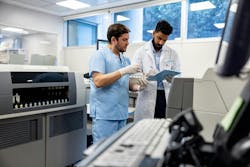The role of training in error prevention for clinical laboratory professionals
Every day, clinical laboratory professionals stand at the vanguard of patient safety by ensuring that errors in laboratory testing are either prevented or identified and managed. Errors in the clinical laboratory testing process can have serious consequences. The ramifications in delayed interventions for sepsis patients and stroke patients can be devastating. Inappropriate treatments can cause undue harm and expense, and not just from a financial position — some expenses cannot be measured, such as decreased trust in the health system. Regardless of the scenario, errors in laboratory testing can compromise the reliability of diagnostic information, leading to erroneous conclusions or ineffective therapeutic interventions. Clinical laboratory leaders can enhance error prevention by strengthening their team’s on-the-job training through elevating personnel competency and cultivating a culture of continuous improvement.
Competency assessment versus attainment
Clinical laboratory leaders should be acquainted with the CLIA (Clinical Laboratory Improvement Amendments) guidelines for competency assessment for laboratory personnel. Initially, competency must be assessed upon hiring or assignment to new testing procedures. This typically occurs after initial “on the job” training. Ongoing assessment is required at six months for new personnel, and then subsequently, competency is assessed annually for all employees. Additionally, competency assessments should occur whenever significant changes in laboratory procedures, methodologies, or instrumentation take place. Furthermore, prompt assessment is necessary if performance problems or errors are identified. These guidelines ensure that laboratory personnel remain competent and proficient in their roles, promoting the quality and reliability of laboratory testing processes.
Regardless of the interval (initial, six months, etc.), the six elements of the CLIA competency assessment must be present. Firstly, direct observation of routine patient test performance ensures personnel can proficiently conduct testing procedures correctly. Secondly, monitoring the recording and reporting of test results verifies adherence to standard operating procedures and regulatory requirements. Thirdly, reviewing test results, proficiency testing performance, and quality control records assesses personnel's ability to manage results and maintain quality standards. Fourthly, direct observation of instrument maintenance and function checks confirms personnel's competence in instrument upkeep and troubleshooting. Fifthly, assessment of problem-solving skills evaluates personnel's ability to identify and resolve issues effectively. Finally, evaluating basic knowledge through written exams or oral assessments ensures personnel possess the foundational understanding required for safe and competent performance. These elements collectively provide a baseline framework for assessing the competency of laboratory personnel.
Attaining competency encompasses the acquisition of skills and knowledge, while assessing competency involves evaluating the extent to which those skills and knowledge have been acquired and can be effectively applied. Clinical laboratory leaders are now faced with a challenge because current CLIA standards for competency assessment do not necessarily address the complexities of clinical decision making. CLIA merely defines how competency should be assessed, as opposed to how competency should be attained. The CLIA six elements do not provide laboratory leaders with a roadmap for attaining competency, which is a crucial aspect of error prevention. Complexities in clinical decision making are ever more present, so every laboratory professional, regardless of their role, should attain competencies that address the intricacies associated with their particular work.
Elevating personnel competency
Methods for attaining competency should be a joint effort from the laboratory medical director, administrative leaders, and technical leaders in the laboratory. It also takes significant input from experienced team members from all roles. Engagement and collaboration from all are essential. Clinical laboratory personnel should be taught and trained to analyze situations critically by recognizing patterns and identifying deviations from expected results that may indicate an error. Additionally, they should learn how to troubleshoot problems systematically, employing logical approaches to isolate and address the root causes of errors.
Phlebotomists and pre-analytic staff should be trained to think critically about various tests and the requirements of those tests. For example, during my phlebotomy training program, my clinical instructor required students to know which tests could be performed on corresponding tube types based on the anticoagulant present in the tube. Various tests would be listed off by the instructor, and the students needed to know if the hepatitis panel could be performed on the same specimen as the CMP (comprehensive metabolic panel). This of course corresponded to the tests and specimen types that were validated on the instrument, so this was laboratory specific to an extent. On the surface, this may appear to be a great deal of work, but ultimately, the phlebotomist becomes empowered to make appropriate decisions regarding use of tubes, which can minimize errors where specimens are received and accessioned into the laboratory for analysis.
One way that the testing personnel can attain competency is through the use of scenario-based training. This is especially true in trauma and emergency blood banking situations. Once baseline blood banking competency has been attained, laboratory leaders can create scenarios to mimic the pressures of real-life situations to better equip the trainees. For instance, the blood bank can call a mock trauma, using the phones and/or alarms, and run through scenarios such as preparing and modifying blood products while timing the trainees. Time standards can be set for the completion of coolers or trauma packs.
While performing the tasks necessary to complete the cooler, the trainees may also be given “unknown” factors, such as repeated phone calls asking for the status of the blood products, or a notification that the ED is unable to send a runner to pick up the blood. These types of scenarios can allow trainees to develop critical thinking skills under pressure, where the likelihood of errors occurring increases. Following the training scenario, it is important to debrief each scenario with the trainee, offering both positive and constructive feedback on their performance. In every case, and for every role, laboratory leaders can deploy scenario-based training as a means to prevent errors, especially when personnel are under pressure.
Leading the change to job integration
The relationship between training and a culture of continuous improvement is essential to error prevention in the clinical laboratory. Routine training not only equips laboratory personnel with the necessary knowledge and skills to perform their duties accurately and efficiently, but also instills a culture of continuous improvement. In a culture of continuous improvement, laboratory personnel are enabled to seek out opportunities for growth, actively participate in training programs, and apply new insights and best practices to their work. This continuous cycle of learning, feedback, and adaptation enhances personnel competency, promotes critical thinking and problem-solving skills, and fosters a proactive approach to quality assurance. Personnel who are supported with tools and resources to continuously improve are better equipped to identify and mitigate potential sources of error, which enhances the reliability and integrity of the laboratory testing process.
However, shifting the mindset of training from a single event to a fully integrated aspect of one's job demands focused planning and execution. Leaders play a crucial role in communicating the value of continuous learning, emphasizing its importance in achieving organizational objectives and its role in error reduction. By aligning training initiatives with the laboratory's strategic goals, leaders provide employees with a clear understanding of how their learning efforts contribute to overall success. Integration of training into daily work processes is essential and is achieved through methods such as incorporating training modules into onboarding processes or scheduling regular learning sessions. Through these efforts, laboratory leaders can cultivate a culture of continuous improvement, driving error reduction in laboratory operations.
Final remarks
The consequences of errors in the total testing process can be severe and the complexities of clinical decision making create more opportunities for errors to occur. As a means to prevent errors, laboratory professionals should be trained to think critically, especially under pressure. This luxury can empower the laboratory team to provide clarity in the midst of complexity. Additionally, laboratory leaders should work to empower their personnel to continuously improve their skills. Training is a cornerstone of continuous improvement and clinical laboratory leaders can cultivate team members that are vigilant, responsive, and committed to error prevention. By enriching personnel competency attainment and fostering a culture of continuous improvement, clinical laboratory leaders can strengthen their laboratory’s error prevention efforts and amplify the integrity of the laboratory testing process.
About the Author

Stephen Bishop, MBA, MS, CLS, MLS(ASCP)CM, CPHQ
MBA, MS, CLS, MLS(ASCP)CM, CPHQ
is currently the Market Director of Laboratory Services at CommonSpirit Health, Southern California. Stephen is passionate about healthcare leadership, clinical laboratory education, and process improvement.
